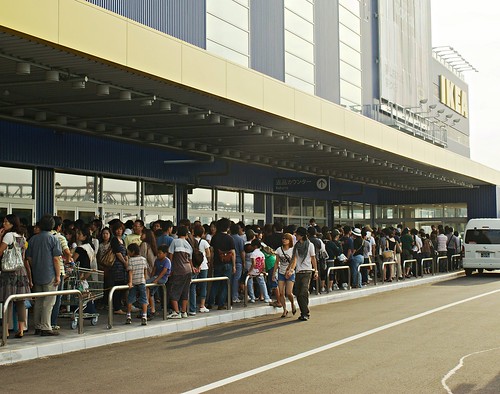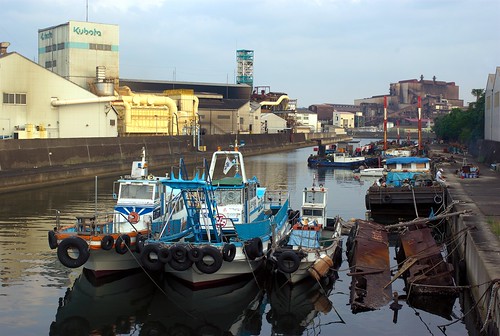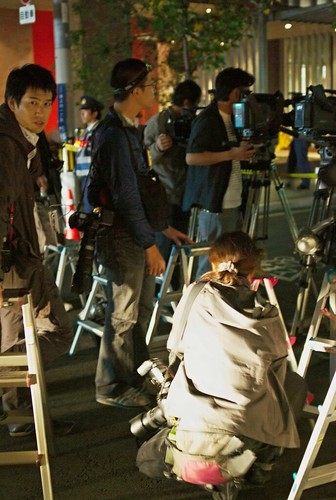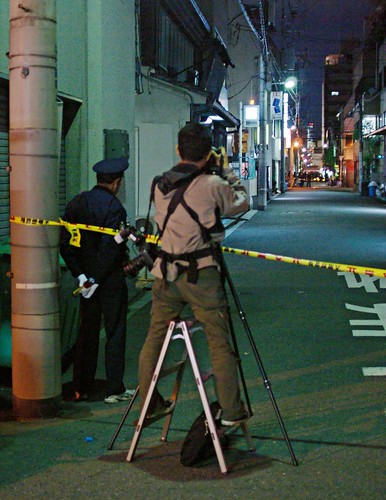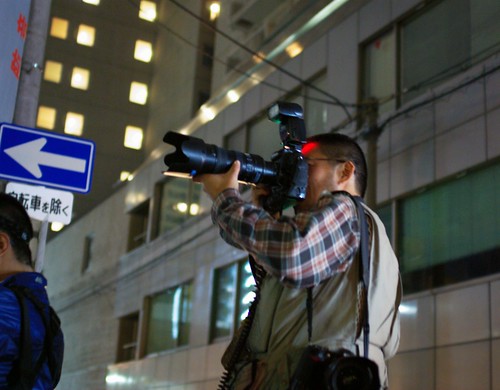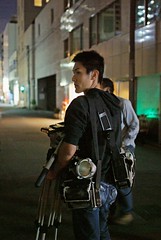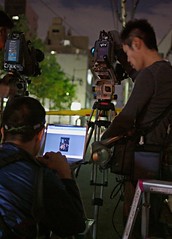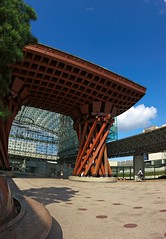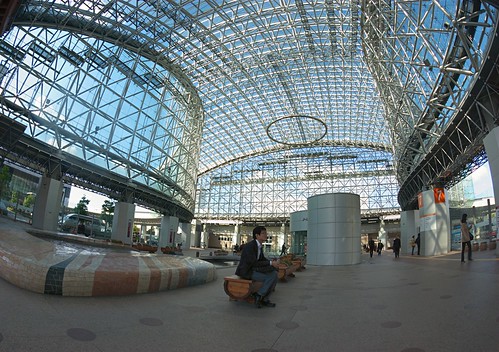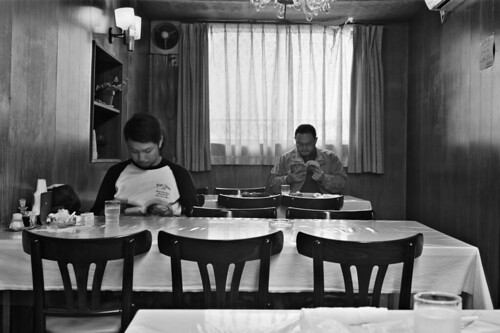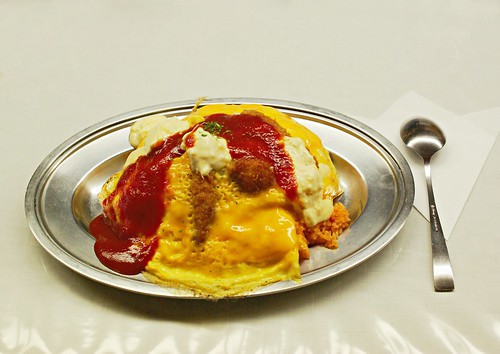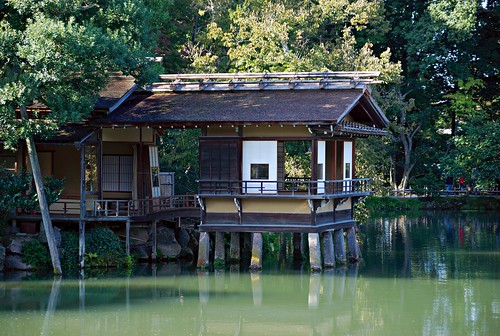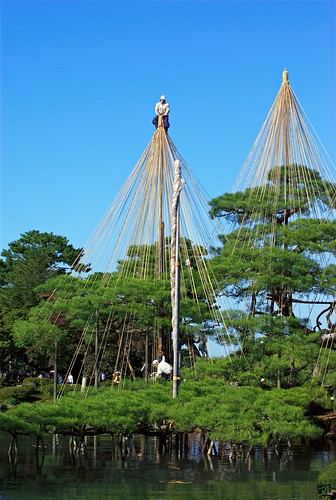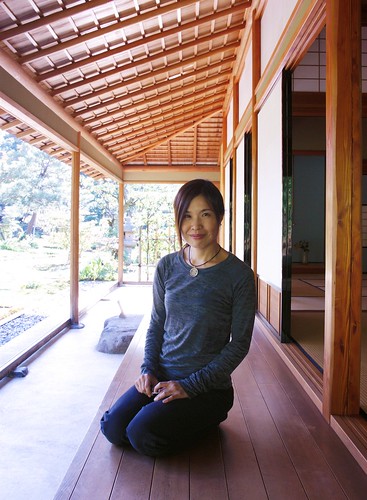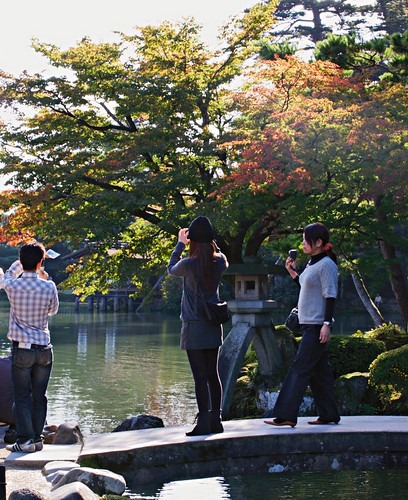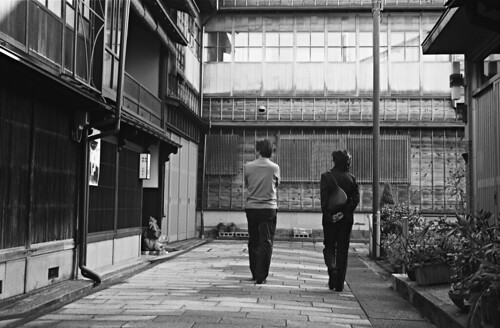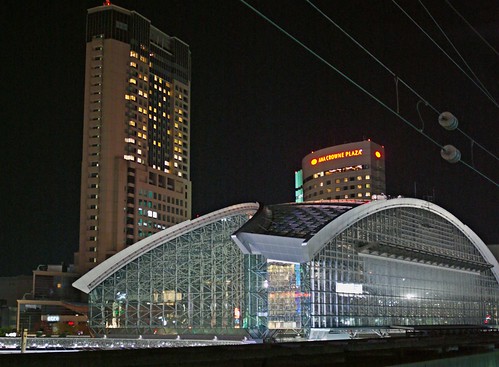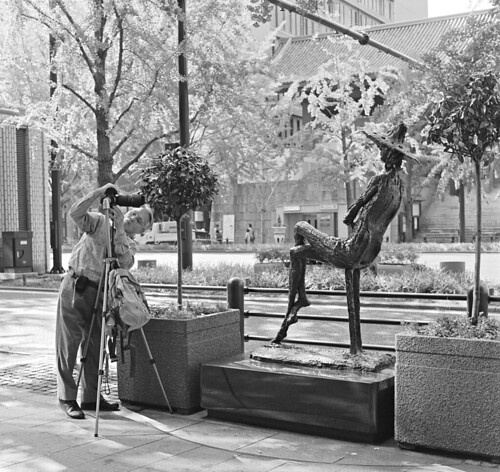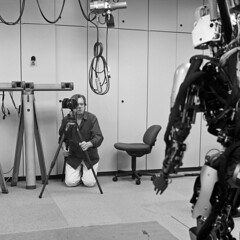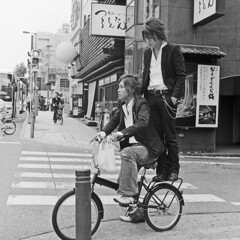I've finally finished "Reason" by Miyuki Miyabe, after just about a year of reading, mostly on the morning train. To recap, the story begins with a multiple murder in a Tokyo high rise; four people are dead - three stabbed inside the apartment, one jumped or pushed from the balcony. It turns out they are not related to each other in any way even though they lived together as a family.
Miyabe explores the reasons for the murder by looking at the lives and backgrounds of all the people involved with or touched by the events. It is written in a documentary style where the author interviews people about a year after the crime, trying to piece together the events leading up to the murder. We often get to hear about the same event or situation from different viewpoints; sometimes the recollections differ so much they could be different events altogether. Some characters are appealing and likable, others are truly disagreeable. But Miyabe treats them all evenhandedly and with a surprising amount of sympathy and understanding.
「理由」 means "reason" or "motive" but also "pretext". The title alludes to unearthing the reasons for the murder, but the actual murder is really only discussed in the first part of the book, and then again at the very end. The crime is just a pretext for Miyabe to delve into the lives of a disparate group of characters that would otherwise have little in common. And I really mean delve; even staffage characters that would otherwise come and go within a single paragraph can still get a page or two with their life story, their concerns and their worries. It seems clear to me that Miyabe is really writing about the lives of all these ordinary people, and the crime story is there mostly to give her a reason to do so.
So, how was it?
The book is difficult. Really difficult; in fact, my teacher first recommended it to me but soon had second thoughts. She realized that it was too difficult for my level, but decided not to discourage me by telling me so. At first I could barely manage two or three sentences over one commute, and even now towards the end I manage perhaps five or six pages on a good day. One reason is that we have a lot of people in the book, more than a dozen central characters and perhaps twice as many again in supporting roles. All of them have their own way of speaking, often using Tokyo dialect, schoolyard slang or rough spoken language. In one chapter a lawyer was using legal language and terminology to such an extent I basically gave up on understanding it all and just focused on getting the gist of his explanation. When a plot follows just a few central characters you get used to the way they speak, but here we keep shifting from person to person, never staying long enough to really get comfortable.
The second source of difficulty is her use of unusual or archaic writing. A Japanese word can often be written either in hiragana or kanji, and sometimes with a choice of kanji. Problem is, Miyabe has never met an unusual kanji she didn't like. Some words are normally written using hiragana, such as "ある", to exist; but Miyabe prefers to use the unusual kanji form "在る" whenever she can. The word "listen" is normally written as "聞く" but Miyabe prefers to use "訊く" instead, with the same meaning but rare enough that my Japanese-English dictionary doesn't even have it. ALC has 774 example sentences using "聞く", and 1 (one) using "訊く". A few unusual forms like this is OK, but she uses them a lot, and that slows down my reading something fierce. It's like linguistic flypaper, trapping the freeflowing tale in a sticky mess of obscure language.
With that said, the book is good. It is, in fact, excellent. I spent a year slowly reading through the slow story, endless digressions and asides, and getting caught in the language traps she litters throughout the text - and yet I never once thought about quitting, that's how good it is. She is simply a very engaging storyteller, and can relate something seemingly banal, like the business difficulties of a sandwich shop, in a way that makes it interesting, even engrossing. The most ordinary lives cease to be ordinary once they get depicted with skill and flair. If you can read Japanese (and better than me, preferably) you could do much worse than to pick this one up.
What's next? Don't know yet. I'll wait a bit before I decide what to tackle next. Another mystery or crime novel would be good, though a little easier and faster to read. I'll see what my teacher will recommend; this one was an excellent choice so I have no doubt her next suggestion will be good too.
Thursday, November 27, 2008
Tuesday, November 25, 2008
IKEA
Ikea is: A source of inexpensive design furniture; a famously penny-pinching but attractive employer; killer of local furniture stores; a symbol of globalized trade gone wild. For Swedish exiles like me, Ikea is a so-so restaurant and seller of hard to find Swedish foods that just happens to also sell furniture in the back.
Ikea is really popular here; during rush hours you still sometimes have to stand in line outside the store to get in. Better to go during off-hours with less people, no lines to the restaurant and more time to browse.
The warehouse area feels like the soul of Ikea. This is where the magic happens; where the shimmering dream from the showroom upstairs comes true, manifested in oblong boxes with mystical incantations like "Granemo", "Ektorp" and "Numerär" offered in supplication to appease the Dark Gods of Furniture Assembly Resting Eternally (Though Very Comfortably) Outside Space And Time1.
Last year we got an Ikea store in Kobe, out on Port Island in the bay. It's right next to a train station and the trip from home takes us an hour or so; we often go to Kobe anyway so it's not far. This August, another store finally opened in Osaka. It's out in the Taishō harbour district to the southwest, not that far from where we live. This is great - or, it would have been had the location been slightly different.
Ikea likes harbours and industrial parks. The land is cheap, it's easy to reach with a car or delivery truck, and such areas are often economically depressed so they can get tax breaks and development help from the local governments. But the Osaka store out by the bay is far from any train or subway station. You can take the subway halfway to the store, then line up for an Ikea shuttle bus running every twenty minutes; or you can go to Namba, then stand in line for the shuttle bus running from there. Either way it takes almost exactly as long for us to go to Ikea in Osaka as to Ikea in Kobe - and when we go to Kobe we don't need to stand in line for a bus.
On the other hand, the Osaka Ikea is right in the harbour area - a real, working industrial harbour - and the human male isn't born that doesn't find freight ships, cranes, and the whole dilapidated industrial environment fascinating, even romantic. It is, I think, a mix of the big, bulky hands-on technology on display, with the promise of faraway travel and adventure; it's a glimpse of life beyond the ordinary. Just going to the harbour area is a treat, whether or not you actually stop by a furniture store on the way.
The last time we went to Ikea in Osaka, therefore, we didn't go by bus but on bicycle. It is about 8 km if you go more or less straight there. Not that far, especially since much of Osaka is flat and bicycle-friendly. On the other hand, "straight there" is pretty much impossible for me, so it took a while.
There's several large, high bridges in the harbour, and amazingly most of them have walkways and bicycle lanes on them. There's no better place to get a good birds-eye view of the area. Just don't be too worried about heights.
There's lots of places like this in the area. Small side canals with rundown piers, forgotten old boats and equipment. Sure, they're dirty, dingy and decaying. Yes, they're marks of poverty and failure. No, none of these places will ever be finalists in the Urban Sparkling Radiant Freshness Award of the Year competition. But they have a hesitant beauty of their own, I think, one worth preserving or at least acknowledge before they disappear.
---
#1If you happen to own a Theremin, this is the time to take it out for some quick sound effects.
Ikea is really popular here; during rush hours you still sometimes have to stand in line outside the store to get in. Better to go during off-hours with less people, no lines to the restaurant and more time to browse.
The warehouse area feels like the soul of Ikea. This is where the magic happens; where the shimmering dream from the showroom upstairs comes true, manifested in oblong boxes with mystical incantations like "Granemo", "Ektorp" and "Numerär" offered in supplication to appease the Dark Gods of Furniture Assembly Resting Eternally (Though Very Comfortably) Outside Space And Time1.
Last year we got an Ikea store in Kobe, out on Port Island in the bay. It's right next to a train station and the trip from home takes us an hour or so; we often go to Kobe anyway so it's not far. This August, another store finally opened in Osaka. It's out in the Taishō harbour district to the southwest, not that far from where we live. This is great - or, it would have been had the location been slightly different.
Ikea likes harbours and industrial parks. The land is cheap, it's easy to reach with a car or delivery truck, and such areas are often economically depressed so they can get tax breaks and development help from the local governments. But the Osaka store out by the bay is far from any train or subway station. You can take the subway halfway to the store, then line up for an Ikea shuttle bus running every twenty minutes; or you can go to Namba, then stand in line for the shuttle bus running from there. Either way it takes almost exactly as long for us to go to Ikea in Osaka as to Ikea in Kobe - and when we go to Kobe we don't need to stand in line for a bus.
On the other hand, the Osaka Ikea is right in the harbour area - a real, working industrial harbour - and the human male isn't born that doesn't find freight ships, cranes, and the whole dilapidated industrial environment fascinating, even romantic. It is, I think, a mix of the big, bulky hands-on technology on display, with the promise of faraway travel and adventure; it's a glimpse of life beyond the ordinary. Just going to the harbour area is a treat, whether or not you actually stop by a furniture store on the way.
The last time we went to Ikea in Osaka, therefore, we didn't go by bus but on bicycle. It is about 8 km if you go more or less straight there. Not that far, especially since much of Osaka is flat and bicycle-friendly. On the other hand, "straight there" is pretty much impossible for me, so it took a while.
There's several large, high bridges in the harbour, and amazingly most of them have walkways and bicycle lanes on them. There's no better place to get a good birds-eye view of the area. Just don't be too worried about heights.
There's lots of places like this in the area. Small side canals with rundown piers, forgotten old boats and equipment. Sure, they're dirty, dingy and decaying. Yes, they're marks of poverty and failure. No, none of these places will ever be finalists in the Urban Sparkling Radiant Freshness Award of the Year competition. But they have a hesitant beauty of their own, I think, one worth preserving or at least acknowledge before they disappear.
---
#1If you happen to own a Theremin, this is the time to take it out for some quick sound effects.
Wednesday, November 19, 2008
Press Photo
We had an accident just two blocks away from here recently, at a small restaurant. A group had eaten nabe - stew cooked at the table on a small gas burner. When the table was cleared away some less than blindingly bright waiter put the gas burner on an unused kitchen gas stove. A cook turned on the stove by mistake, and found out why small gas canisters carry big warnings about never ever putting them in a fire. Nobody died in the resulting explosion, but four people had to be taken to the hospital.
Since nobody knew the causee, or whether there'd be further explosions, the fire brigade and police came out in force, with lots of loud trucks and cars, and cordoned off a good part of the street. And of course journalists, press photographers and TV crews congregated like moths to a fire. We passed by on our evening walk a little later and stopped to watch. I didn't care about the accident site - there was nothing much to see from far away, and unlike the journalists I have no business with other people's misfortune - but the assembled photographers were interesting. I figured I could always learn something new about photography from seeing how they worked. And I did - apparently the first rule of photojournalism is "always bring your stepladder".
The first thing that hit me was, everybody had a stepladder. Everybody. People discuss cameras, lenses, tripods, strobes and so on, but nobody brings up the humble aluminum stepladder as a crucial piece of photographic equipment. It makes sense, of course. If you're a press photographer you tend to cover visually striking events, and such events will bring a crowd that you'll need to get above or ahead of in order to get a decent picture.
Now, this is either pure force of habit or something like a good-luck charm, but I fail to see any conceivable advantage of the stepladder here. Maybe he just feels naked without it. Maybe he has an irrational fear of naked mole rats and wants a bit of safety distance to the ground while he's otherwise occupied. I didn't ask.
The accident happened at night and on a quiet back street, and the initial drama was already over when we came by, so there weren't that many people about anymore. Still, there was plenty enough photographers still milling around. And as we can see, a stepladder is useful as a laptop table too, when you need to review your shots.
Since nobody knew the causee, or whether there'd be further explosions, the fire brigade and police came out in force, with lots of loud trucks and cars, and cordoned off a good part of the street. And of course journalists, press photographers and TV crews congregated like moths to a fire. We passed by on our evening walk a little later and stopped to watch. I didn't care about the accident site - there was nothing much to see from far away, and unlike the journalists I have no business with other people's misfortune - but the assembled photographers were interesting. I figured I could always learn something new about photography from seeing how they worked. And I did - apparently the first rule of photojournalism is "always bring your stepladder".
The first thing that hit me was, everybody had a stepladder. Everybody. People discuss cameras, lenses, tripods, strobes and so on, but nobody brings up the humble aluminum stepladder as a crucial piece of photographic equipment. It makes sense, of course. If you're a press photographer you tend to cover visually striking events, and such events will bring a crowd that you'll need to get above or ahead of in order to get a decent picture.
Now, this is either pure force of habit or something like a good-luck charm, but I fail to see any conceivable advantage of the stepladder here. Maybe he just feels naked without it. Maybe he has an irrational fear of naked mole rats and wants a bit of safety distance to the ground while he's otherwise occupied. I didn't ask.
The accident happened at night and on a quiet back street, and the initial drama was already over when we came by, so there weren't that many people about anymore. Still, there was plenty enough photographers still milling around. And as we can see, a stepladder is useful as a laptop table too, when you need to review your shots.
Monday, November 17, 2008
Kanazawa
In our slowly evolving grand tour of the Japanese islands we took a day trip to Kanazawa a couple of weeks ago. It's a medium-sized city on the Japanese Sea side, due north from Kansai. The train from Osaka takes about 2.5 hours, making it just reachable without spending too much time traveling. An acquaintance of Ritsuko's was having an art exhibition at the city museum giving us a reason to go.
The place is said to be famous for its seafood - but then, Japan is an island nation and obsessive about food; every place here is famous for its seafood, in its own eyes if nothing else. In fact, if there's a place in Japan not famous for its seafood - perhaps even known for its lack of quality and variety - I think I would like to visit it. So would, I guess, plenty of other people. Places become travel destinations when they offer something different after all, and whatever could be more different here than not having good seafood?
The place is said to be famous for its seafood - but then, Japan is an island nation and obsessive about food; every place here is famous for its seafood, in its own eyes if nothing else. In fact, if there's a place in Japan not famous for its seafood - perhaps even known for its lack of quality and variety - I think I would like to visit it. So would, I guess, plenty of other people. Places become travel destinations when they offer something different after all, and whatever could be more different here than not having good seafood?
It could have a big market with excellent meat, poultry, and eggs, stalls heaped high with vegetables, cheeses, locally made miso and tofu - any and all kind of land-based food you could imagine. In one corner would be a single tourism board-employed fishmonger offering a small, sorry selection of seafood. Perhaps a few sad-looking bony river fish and a single pack of Norwegian smoked salmon well past its sell-by date. You'd have people flocking five deep around the poor man, taking his picture, buying up local produce for presents back home and fighting for phone straps and postcards featuring the local logo. Perhaps a cute, cartoonish dead-smelly-fish character would be appropriate?
Anyway, Kanazawa. It's a decent-sized city of 450.000 people, larger than Aomori (which we visited recently) by almost half, and with a decently busy atmosphere. Plenty of tourists on the street too. There's the art museum I mentioned above; some restored old entertainment neighbourhoods; the remains of the castle; a large, bustling fish market; and, most famous, the Kenroku garden, one of the three foremost gardens in Japan.
We came off the train (scenic ride, by the way) and walked from the station, via the fish market towards the museum. The whole city is quite compact so walking around is no problem. We stopped by for something to eat before going to the museum; culture is best experienced on a full stomach.
Restaurant Ōtsuka is an inexpensive eatery on a back street in central Kanazawa. It's a place of buckling linoleum floors and dark brown wood interior getting darker and browner from many years of tobacco smoke and stains. Tin plates, scratched glassware and beer crates in the corner. If you're looking for luxury, look elsewhere.
But if you're looking for a homey atmosphere, wonderful food, shelves of manga to read and generally a place to put up your feet and relax for a while then this is the place to go. Were I to live in Kanazawa I would happily grow old(er) and fat(ter) in this place.
Hanton rice is a local specialty and a specialty at the Ōtsuka restaurant. Like the nationally popular dish of omuraisu (from "omelet and rice"), it's a heaping of tomato sauce-flavoured rice wrapped in a creamy omelet. But hanton rice adds fried seafood - fish and shrimp - to the omelet and tops it with big dollops of ketchup and mayonnaise. This is some seriously heavy food, true, and probably a health disaster but it is absolutely, amazingly delicious. I wish there was a place in Osaka that served this.
After lunch we walked over to the museum. It is startlingly like just about any recent art museum anywhere in the world. A low-slung structure with white, angular surfaces, and a sprinkling of permanent artworks comissioned for the site. As I believe I wrote in the Aomori post, I consider this a good thing. You come there for the exhibitions and not the building, and anything that elevates the artwork over the architecture is good. As always there's no good pictures of the actual exhibition we came for and any photography in the exhibition halls was forbidden.
They do a good job at this museum of keeping visitors - younger visitors especially - interested with their permantent installations. This pool was really cool, and very popular too.
I'm a little ambivalent towards this kind of piece though. It's basically having one fun or offbeat idea and taking it as far as it goes. I love that kind of stuff, and many a technology or science demonstration is conceived and realized in the same way. I'm just not sure it qualifies as art. This pool doesn't seem to have any meaning or message to the viewer other than "Hey, look, cool isn't it?" This would fit in a trade-show booth (ok, a big booth) or world expo pavilion as much as an art museum. Not that I'm complaining.
The Kenroku gardens is the main reason most people come to this city. It's considered one of the three top public gardens in the country. It is very beautiful, with sculpted greenery, carefully planned views and dotted with teahouses and other small buildings. It is also overrun with visitors. Out of the way corners and the less spectacular views are easy enough to get to, but the main points of interest were frankly so crowded we gave up on trying to get a good look.
Every autumn workers attach ropes to the wide-branched trees in the park like this so that the heavy, wet snow of winter doesn't break them. No safety harnesses needed for this job, apparently.
You can find solitude and stillness in the park - if you are patient and if only for the 1/40 of a second you need for a picture.
This stone lantern is famous, and stands as a symbol of the city. It is apparently also all but impossible to photograph this time of day without catching half a dozen other people. Popular spot.
After the gardens we walked across the river to Higashi Chayamachi ("Eastern Tea house street"), an old Geisha entertainment street, preserved more or less intact. Nice, though again full of people. There's some teahouses, restaurants and the inevitable accessory and sweet shops; Japanese tourists are more commonly women rather than men and tourist spots plan accordingly.
By the time we passed by the fish market again - to pick up some crab we'd bought - it was getting dark already. We had dinner at a sushi place in the market, then walked across the street to a department store with a very relaxing cafe with a good city view on the eight floor.
It's interesting to compare Kanazawa with Aomori. Both are regional hubs in backwater areas; both have notable tourist draws and both have fairly recent new museums and other facilities for tourists. Now, we had much better weather going to Kanazawa (an oddity as Kanazawa weather apparently is very unstable) so the overall impression is of course brighter and busier. It certainly felt more alive than Aomori did, it is significantly larger, it is closer to major metropolitan areas and its foremost visitor draw - the garden - is very famous indeed. That said, if I had to choose a place to live I think I'd prefer Aomori. It was a bit slow and a bit under the weather and didn't have the same sparkle as Kanazawa did. Kanazawa certainly has more things to see and do; the museum and fish market are both bigger and better in Kanazawa than Aomori. But after two days and one night in Aomori I still wanted to stay longer. Kanazawa, on the other hand, was fun but a day trip felt like plenty enough.
All pictures are available in the Kanazawa set here.
Thursday, November 13, 2008
Gender Gap Rankings
World Economic Forum has posted their annual survey (pdf format) of the gender gap in different countries. They measure criteria like political and economic opportunities, access to health care and education. The index measures the male-female gap only; the absolute level available is not taken into account. A poor country with very limited health care resources may thus score highly on health care access if those limited resources are available equally to men and women, for example. An explanation of the criteria (from last year) is available as a pdf file here: index2007.pdf
My home country Sweden drops to third place after Norway and Finland, with Iceland and New Zealand rounding out the top five; the United States is at 27, ahead of Belgium (28) and Canada (31); China is at 57. Japan sits at 98, slightly ahead of Kuwait (101) and Nigeria (102) but behind Malaysia (96) and Indonesia (93). Sad to say, I don't think that ranking is in any way unfair. Japan does very well in health care access and access to primary schools but pretty much drops the ball on the other criteria. With a contracting population ahead, the last thing this country needs is to discourage half its citizens from being full economic and social participants, or for everyone to have to choose between family or working life.
My home country Sweden drops to third place after Norway and Finland, with Iceland and New Zealand rounding out the top five; the United States is at 27, ahead of Belgium (28) and Canada (31); China is at 57. Japan sits at 98, slightly ahead of Kuwait (101) and Nigeria (102) but behind Malaysia (96) and Indonesia (93). Sad to say, I don't think that ranking is in any way unfair. Japan does very well in health care access and access to primary schools but pretty much drops the ball on the other criteria. With a contracting population ahead, the last thing this country needs is to discourage half its citizens from being full economic and social participants, or for everyone to have to choose between family or working life.
Tuesday, November 11, 2008
Chedi Luang
In our neverending quest for places to eat we've found a really good Thai restaurant just a fifteen-minute walk away. Chedi Luang (beware: annoying Flash-only website) is a pleasant restaurant in the Kitahorie district just west of Amemura. This area, like the nearby Shinmachi area west of us, is home to a fair amount of "young" businesses like designer shops, fashion, bicycle shops ("fixies" and such, not your grandma's bikes), design and acting schools, music instrument stores and so on. And along with it, a steady influx of fairly inexpensive but good modern-style restaurants.
Chedi Luang has a weekend lunch menu with a single dish for about 1000 yen, or a lunch set for about 2000. Not something you'd get everyday, but for the occasional weekend lunch it's perfect. The lunch set is delicious and more than worth the price. The starter was possibly the best Tom yam soup I've ever had, and the main menu is six or so dishes, including a curry and a main dish of your choice. Dessert is a good-sized bowl of coconut jelly and fruit. The presentation and quality leads me to think that the weekend lunch (unlike the weekday buffet) has the same dishes, prepared in the same way, as the dinner menu. Good place for a long, lazy Sunday lunch.
Chedi Luang has a weekend lunch menu with a single dish for about 1000 yen, or a lunch set for about 2000. Not something you'd get everyday, but for the occasional weekend lunch it's perfect. The lunch set is delicious and more than worth the price. The starter was possibly the best Tom yam soup I've ever had, and the main menu is six or so dishes, including a curry and a main dish of your choice. Dessert is a good-sized bowl of coconut jelly and fruit. The presentation and quality leads me to think that the weekend lunch (unlike the weekday buffet) has the same dishes, prepared in the same way, as the dinner menu. Good place for a long, lazy Sunday lunch.
Sunday, November 9, 2008
Development
Learning about stuff is fun. And the more we learn the more we want to learn more; in other words, we want to learn more about the things we already learned more about. Or something to that effect. Anyway, I started using film a while ago, just to play with some older cameras and get some experience with the medium. That turned out to be amazingly fun so I've continued to use film this autumn. That made me want to learn more about the whole process, so now I've started to develop film myself.
Black and white film development turns out to be easy. It is cheaper than having a store do it (half price or much less, depending), and for medium-format it's much faster: the store takes three or four days, while doing it at home takes an hour or so. It gives you more control over the result - and more ways to screw up too, of course. You don't need a blacked-out room or anything, and all equipment, chemicals and stuff fits on one shelf in my study. The one single thing that takes a bit of practice is the first step of rolling up the film onto a spool for development, and doing it without seeing what you do. I had to practice doing it half a dozen times with an expired roll of film until it "clicked" and I got the knack of how to do it easily.
Some more examples below; please click through as the images are better viewed large.
Yves Gellie is a french photographer that can take better pictures using a pointed stick than I cold ever do with a camera. He visited the lab to take a picture for a project of his. Of course I had to take a shot of him working. That's a Mamiya 7 he's using in that picture, by the way, and no, I would not mind having one.
I realized I hadn't taken a robot picture in black and white so I set up a simple cross lighting setup and the Yashica on a tripod. One of the great things about black and white, by the way, is that you don't have to care about the color of your lights. The lighting are two dirt-cheap construction site lights and nothing else. Had I taken it in color it'd be a confused riot of red and orange from the construction lights, green from the ambient overhead flourescents and a bit of bluish daylight from out on the left. In black and white it's all smooth, pleasant tones of gray.
Black and white film development turns out to be easy. It is cheaper than having a store do it (half price or much less, depending), and for medium-format it's much faster: the store takes three or four days, while doing it at home takes an hour or so. It gives you more control over the result - and more ways to screw up too, of course. You don't need a blacked-out room or anything, and all equipment, chemicals and stuff fits on one shelf in my study. The one single thing that takes a bit of practice is the first step of rolling up the film onto a spool for development, and doing it without seeing what you do. I had to practice doing it half a dozen times with an expired roll of film until it "clicked" and I got the knack of how to do it easily.
Some more examples below; please click through as the images are better viewed large.
Yves Gellie is a french photographer that can take better pictures using a pointed stick than I cold ever do with a camera. He visited the lab to take a picture for a project of his. Of course I had to take a shot of him working. That's a Mamiya 7 he's using in that picture, by the way, and no, I would not mind having one.
I realized I hadn't taken a robot picture in black and white so I set up a simple cross lighting setup and the Yashica on a tripod. One of the great things about black and white, by the way, is that you don't have to care about the color of your lights. The lighting are two dirt-cheap construction site lights and nothing else. Had I taken it in color it'd be a confused riot of red and orange from the construction lights, green from the ambient overhead flourescents and a bit of bluish daylight from out on the left. In black and white it's all smooth, pleasant tones of gray.
Wednesday, November 5, 2008
Ubuntu
There's been a somewhat stressful few weeks lately; this week we're shooting the final video presentation for the project, and ATR has its yearly Open House. But while the run-up has been busy this week is remarkably slow as all the shooting, presentations and visitors pretty much preclude any real work. So I've taken the opportunity to upgrade my laptop to the newest version of Ubuntu.
For those that do not know, Ubuntu is an operating system (like Windows or Mac OSX) based on Linux. I've used Linux for many years but then, I'm pretty much hopelessly geeky. Of course, lots of people - you included - are using Linux without knowing it: you'll find it in your cable modems, cable-TV set-top boxes, routers and other electronic devices; many of the Internet sites you visit are served to you by Linux. When you use any Google application like Gmail or Google Maps you are using Linux. But while Linux has worked great for me on my desktop I'd be the first to admit that Linux on your PC is very much not for everyone. Up until now, that is.
Whenever I install a new version I always spend a good deal of time tweaking the new system to fix small issues and get everything working properly. It can take a couple of days of off-and-on tinkering to get everything shipshape. This time it took all of ten minutes, mostly just reentering passwords for my email accounts and such. My only real tweak is getting my keyboard to work. I have the very oddball requirement of using a Swedish keyboard layout on a a Japanese laptop keyboard that is missing a couple of keys vital to Swedish (specifically, the Swedish key for "<>|" to the left of 'z' is missing). I basically need to tell Linux to use a different, unused key for that. Of course you could argue that Linux sucks for forcing me to do such a remapping, but under Windows I have never found any way to do it at all. Under Linux this is a bother; under Windows it is impossible.
Other than the (self-inflicted) keyboard thing everything - and I mean everything - worked right out of the box. Wireless connections, suspend and resume, and things like connecting second screens have been common problem spots for laptops, but now it all just worked with no tweaking needed whatsoever. The included software (and there is a lot included) is all just a bit more polished and smooth than before. The F-Spot photo management software is updated and a lot more polished; the Gimp image editor is steadily improving too and is good enough that I prefer it over Photoshop even though we have both at home.
There are a few things not installed by default that I think people should get. Installing things, by the way, is generally much easier under Linux than Windows. Just about any kind of software (we're talking tens of thousands of packages here) is available through the "package manager". Just open the "Add/Remove applications" and you'll get a nice categorized list of what's available. One thing I recommend is the Inkscape drawing program. Smooth and polished; I use it for all illustrations and drawings. The included spreadsheet is pretty good, but I prefer Gnumeric as it is faster and more stable. Install Macromedia Flash; it's not included by default because its license doesn't allow it. Also look for VLC, a good film player, and "Ubuntu Restricted Extras" so you can play mp3 and various other music and movie formats.
But if you have some specific application on Windows you just can't do without? Well, we do have our computers for running our applications after all, not for using operating systems. If your program is important to you and there is no good alternative in Ubuntu then you should of course use Windows. If it's only one or two programs, however, and especially if they are "productivity apps" - tax software or stuff like that - then there is the possibility of running it under Ubuntu using "Wine". It is a piece of software that lets you run a lot of Windows software under Ubuntu. It is not perfect by any means but it does work decently. It may well be a solution for that one important software package you still need.
Anyway, just wanted to state that I'm happy with Ubuntu and you might be too. You can download and burn a CD with Ubuntu, then boot from that CD to try it out. It will be a bit slower than having it installed but it will not touch your computer in any way so it's a completely safe way to see what it's about.
For those that do not know, Ubuntu is an operating system (like Windows or Mac OSX) based on Linux. I've used Linux for many years but then, I'm pretty much hopelessly geeky. Of course, lots of people - you included - are using Linux without knowing it: you'll find it in your cable modems, cable-TV set-top boxes, routers and other electronic devices; many of the Internet sites you visit are served to you by Linux. When you use any Google application like Gmail or Google Maps you are using Linux. But while Linux has worked great for me on my desktop I'd be the first to admit that Linux on your PC is very much not for everyone. Up until now, that is.
Whenever I install a new version I always spend a good deal of time tweaking the new system to fix small issues and get everything working properly. It can take a couple of days of off-and-on tinkering to get everything shipshape. This time it took all of ten minutes, mostly just reentering passwords for my email accounts and such. My only real tweak is getting my keyboard to work. I have the very oddball requirement of using a Swedish keyboard layout on a a Japanese laptop keyboard that is missing a couple of keys vital to Swedish (specifically, the Swedish key for "<>|" to the left of 'z' is missing). I basically need to tell Linux to use a different, unused key for that. Of course you could argue that Linux sucks for forcing me to do such a remapping, but under Windows I have never found any way to do it at all. Under Linux this is a bother; under Windows it is impossible.
Other than the (self-inflicted) keyboard thing everything - and I mean everything - worked right out of the box. Wireless connections, suspend and resume, and things like connecting second screens have been common problem spots for laptops, but now it all just worked with no tweaking needed whatsoever. The included software (and there is a lot included) is all just a bit more polished and smooth than before. The F-Spot photo management software is updated and a lot more polished; the Gimp image editor is steadily improving too and is good enough that I prefer it over Photoshop even though we have both at home.
There are a few things not installed by default that I think people should get. Installing things, by the way, is generally much easier under Linux than Windows. Just about any kind of software (we're talking tens of thousands of packages here) is available through the "package manager". Just open the "Add/Remove applications" and you'll get a nice categorized list of what's available. One thing I recommend is the Inkscape drawing program. Smooth and polished; I use it for all illustrations and drawings. The included spreadsheet is pretty good, but I prefer Gnumeric as it is faster and more stable. Install Macromedia Flash; it's not included by default because its license doesn't allow it. Also look for VLC, a good film player, and "Ubuntu Restricted Extras" so you can play mp3 and various other music and movie formats.
But if you have some specific application on Windows you just can't do without? Well, we do have our computers for running our applications after all, not for using operating systems. If your program is important to you and there is no good alternative in Ubuntu then you should of course use Windows. If it's only one or two programs, however, and especially if they are "productivity apps" - tax software or stuff like that - then there is the possibility of running it under Ubuntu using "Wine". It is a piece of software that lets you run a lot of Windows software under Ubuntu. It is not perfect by any means but it does work decently. It may well be a solution for that one important software package you still need.
Anyway, just wanted to state that I'm happy with Ubuntu and you might be too. You can download and burn a CD with Ubuntu, then boot from that CD to try it out. It will be a bit slower than having it installed but it will not touch your computer in any way so it's a completely safe way to see what it's about.
Subscribe to:
Posts (Atom)

